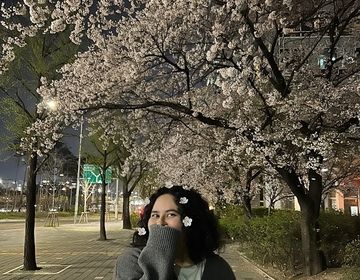An In-Depth Look At The Quarantine Process In South Korea
Fair warning, this post is going to be a little long. However, I want you all to be well prepared for you arrival in South Korea.
If you want to teach abroad in South Korea, you will have to go through a full two week quarantine upon your arrival. How exactly your quarantine is implemented depends on whether you are teaching for a public school or a private school. I am teaching at a private school, or hagwon, in Daegu, South Korea. If you are teaching for a public school, your experience is going to be somewhat different.
For those who are going to be teaching at hagwons, you will most likely be able to quarantine in your own apartment in Korea. Usually this will be whatever apartment your school is providing for you.
It will take, on average, at least 3 hours to get through all of the quarantine, immigration, and baggage claim areas at the airport (so have some snacks ready!). The process is pretty straightforward, since there is only one way for arriving passengers to move through the airport.
So, the first thing all new arrivals to Korea have to do is submit their negative Covid-19 test. At the first "checkpoint" you will need to have your passport, travel declaration form & health declaration form (which they give you on the plane to fill out), and your negative test results.
Upon submitting all the paperwork, they will take your temperature and send you to the next checkpoint. This checkpoint was the crux of the quarantine process. Here you will need to have some help from one of the officials in order to download the "Self-Check Quarantine App," which is used to monitor everyone in Korea who is under quarantine. Through this app, you will have to submit twice daily updates on your temperature, as well as any and all symptoms you might have. Failure to do this, and they will immediately contact the your school, which is essentially responsible for you during your time in Korea.
Once the app is downloaded, you have to provide another official with the contact information of your school, so they can call to confirm that you are expected and that you have an appropriate place to stay during quarantine. After this you will be able to get in line for customs.
The process is fairly straightforward. The hardest part, surprisingly, is juggling luggage, a phone, and all the paperwork all at once. If you are preparing to come to Korea in the near future, I would HIGHLY recommend checking as much of your baggage as you can, so that you can be as hands-free as possible going through all the checkpoints. I think it would help cut down on the stress of the process a lot.
Once through customs, you will go to baggage claim to grab the rest of your luggage.
The next step after leaving baggage claim is finding the bus that will take you to your final destination. Since I was going to Daegu, I was looking for the KTX (high speed train) station in Seoul - about 40 min away.
When you walk through the baggage claim doors into the outer areas of the airport, there will be another offical waiting to help you find the right transportation option. He showed me where to wait for the bus that would take me to the KTX station. Incoming passengers are not allowed to leave the quarantined areas of the airport...even in the waiting areas. It's important to know this in case you are planning on exchanging money or buying a SIM card at the airport. I would HIGHLY recommend doing both of those things before arriving in South Korea.
So, my bus ended up arriving a little early, and after all the passengers had stowed their luggage under the bus, we headed for the KTX station.
I arrived at the KTX station in a little under an hour, where we were escorted by another official to the ticket desk. There, I paid for my ticket to Daegu and for the bus ride I had just taken. The combined total of both was roughly $53, which I thought was a pretty fair price!
The one bump in this fairly smooth process was that I had to wait about an hour at the KTX station for the next train.
Myself, and one other passenger who was disembarking in Daegu, were greeted on the platform by a train attendant who proceeded to lead the two of us directly out of the station and across the street to a collection of taxis.
When I arrived at the cluster of taxis, I was met by a man who had my name on a list. I had to put all of my luggage in a pile, take my passport, and get a Covid-19 test done then and there in a little field tent. They took two samples, one from the back of my throat and the other from my nose.
I had been updating the director of my school as I got through each step on my way to Daegu, and she was going to be meeting me in front of the school when the taxi dropped me off. My two weeks in quarantine were going to take place inside an old classroom that the school had converted into a tiny apartment.
After the two weeks are up I will be moving to the apartment where I will actually be living during my stay in Daegu.
In summary, South Korea has one of the most streamlined and efficient quarantine systems I have ever seen (not that I have much in the way of experience here). I can't even really be upset at the almost 7 hours it took for me to get from the airport to the school in Daegu because the whole thing ran like a well oiled machine. I was, in no small measure, quite impressed.
Depending on where you final destination is, your experience might be a little different from mine. But you can always reach out to CIEE or your school should you need any help during the process!
I know this post was a little tedious and there were no fun pictures to look at, but manhandling all my luggage across of most of South Korea left zero time to stop and take pictures of anything.
If you are planning to travel to Korea anytime soon, feel free to contact me about the quarantine process, and I can answer your questions in more detail!
Related Posts

A Comprehensive Budgeting Guide for English Teachers in South Korea
A Comprehensive Budgeting Guide for English Teachers in South Korea Teaching English in South Korea has become an increasingly popular option for young people looking to travel and get some... keep reading

Professionalism in South Korea as a Native English Teacher
As a native English teacher in South Korea, understanding Korean culture and professionalism is crucial for both personal success and the broader impact you can have on your students. South... keep reading

How to Go to the Doctor in South Korea as an English Teacher: A Guide to Healthcare and Health Insurance
As an English teacher in South Korea, maintaining good health is essential while living abroad. Navigating the healthcare system can seem daunting and stressful at first, especially if you can’t... keep reading

